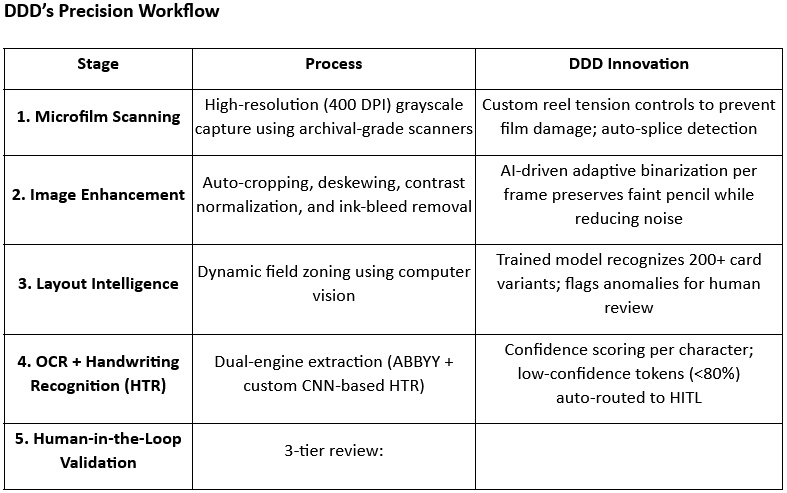How DDD Built a Searchable National Archive in 18 Months
Challenge
A leading European genealogical institute and national archives consortium faced a massive preservation and accessibility challenge: 85 microfilm reels containing over 1.7 million handwritten succession cards from 19th- and 20th-century Dutch civil registries were degrading rapidly. Each card detailed inheritance events, listing family members, estates, and legal references, but the films were fragile, inconsistently formatted, and written in diverse handwriting styles. Manual lookup was slow and error-prone, making the records virtually inaccessible for researchers. The client’s mandate was ambitious: achieve 98% accuracy across all metadata fields and 99.8% on key identifiers, transforming the entire archive into a fully searchable, research-ready digital database within 18 months.
DDD’s Solution
Digital Divide Data (DDD) designed a precision workflow that combined archival scanning, AI-driven text extraction, and human-in-the-loop validation to meet the challenge. High-resolution grayscale scanning preserved fragile reels while minimizing film damage. AI-powered image enhancement corrected distortions and improved legibility, while a custom computer vision model automatically identified over 200 card layouts. DDD then deployed a hybrid OCR and handwriting recognition pipeline, integrating ABBYY with a custom CNN-based model, to extract text with confidence scoring. Low-confidence outputs were routed for human verification through a three-tier review system, ensuring both accuracy and consistency. This seamless integration of automation and expert validation turned unstructured handwritten data into a relational database ready for national-level research.
Impact
The digitized archive now empowers researchers to locate ancestral records in under 10 seconds using simple name, date, or municipality filters, a process that once took hours. The dataset has been licensed to genealogy platforms, broadening public access to millions of family records worldwide. Preservation goals were also achieved: the original microfilms are now safely retired from use, extending their lifespan by decades. Beyond accessibility, the new searchable database has enabled historians and data scientists to analyze long-term migration patterns and naming conventions spanning 150 years, transforming a fragile national treasure into a dynamic, enduring digital resource.










